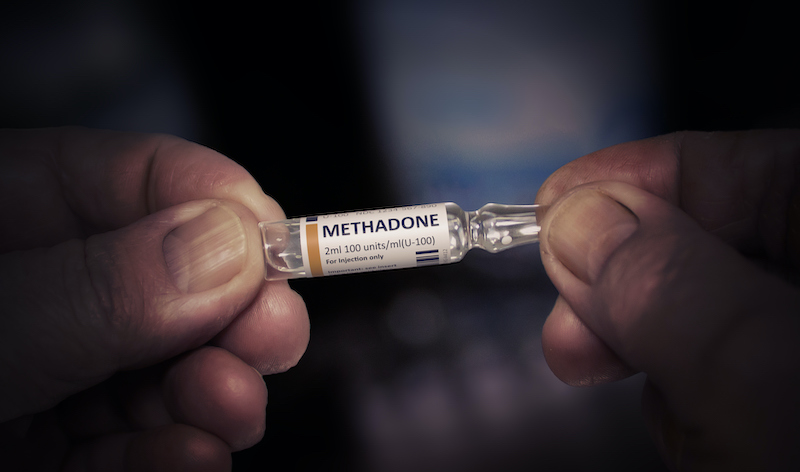
Scholars argue that the ADA’s protections could prevent overdose deaths for people in prison.
Overdose is the third leading cause of death for people in prison. After their release from prison, people are about 129 times more likely to die from a drug overdose than the rest of the population. Opioids remain the largest driver, 72.9 percent, of drug overdose deaths.
In a recent article, David Howard Sinkman and Gregory Dorchak argue that the Americans with Disabilities Act (ADA) is a powerful enforcement tool for the Department of Justice (DOJ) to help jails and prisons provide medications used to treat opioid use disorder, and prevent overdose deaths.
Medications for opioid use disorder (MOUD), like methadone, buprenorphine, and naltrexone, are approved by the FDA and can dramatically reduce fatal opioid overdoses. As Sinkman and Dorchak explain, however, a vast majority of jails and prisons ban these medications. For example, as of 2018, methadone was available in only 22 of 3,300 local jails.
Restrictions on MOUDs, Sinkman and Dorchak argue, not only prevents hundreds of thousands of people in prison from receiving life saving medications, it also violates the ADA.
Opioid use disorder is a chronic brain disease where individuals have a compulsive and prolonged opioid use, but lack a legitimate medical purpose despite the negative consequences resulting from opioid usage. Under the ADA, courts have treated a disability similar to receiving medical treatment for a disability. Thus, the authors note, the ADA protects inmates who require MOUDs and prisons or jails that ban their access may be in violation of the ADA.
Moreover, Sinkman and Dorchak explain, the ADA protects access to the three forms of MOUD, methadone, buprenorphine, and naltrexone, not just one of these, since the medications each have different treatment and prevention purposes that are not interchangeable.
The DOJ is responsible for enforcing “ADA obligations for all programs, services, and regulatory activities” related to corrections. As a result, the DOJ has incorporated ensuring MOUD access in jails and prisons as part of its opioid crisis strategy in various jurisdictions, including Louisiana and Massachusetts.
Sinkman and Dorchak argue that district court litigation liability has helped the DOJ’s outreach to prisons and jails. In Massachusetts, a jail banned methadone, and thus, did not conduct an individualized inquiry into a person’s specific MOUD needs while incarcerated. A federal district court held that the jail’s ban violated the ADA, which required an individualized inquiry by medical personnel. Similarly, a federal district court in Maine held that a county jail violated the ADA for refusing to provide a person with her doctor-prescribed MOUD.
Despite growing support from law enforcement and the Bureau of Prisons to expand MOUD access, MOUD bans continue nationwide. As of 2018, about 500,000 people in prison were denied MOUD treatment, which the ADA protects, even though the people could have benefitted from or were already receiving MOUD.
Sinkman and Dorchak note that although the ADA allows for public entities to impose legitimate safety requirements, for example, in placing a ban on MOUDs, the ban must be based on “actual risks, not on mere speculation, stereotypes, or generalizations about individuals with disabilities.” The authors argue barriers to MOUD access are often a result of stereotypes and stigmas about the treatment or potential diversion concerns, rather than actual risks.
Some forms of MOUD, like buprenorphine and methadone, are also opioids. This, Sinkman and Dorchak explain, leads law enforcement officers to believe that people in prison are simply substituting their drug addiction and thus hindering their recovery. According to the Department of Health and Human Services, however, medication-assisted treatment, such as MOUDs, “does NOT replace one addictive drug with another.” Moreover, as the authors describe, people being treated with MOUDs are not compulsively seeking them, and instead, depend on the medication much like other chronic diseases that require long-term care.
Furthermore, correctional facilities may have diversion concerns when considering providing MOUD access. For example, officers fear that providing one person with a legitimate MOUD prescription would divert the medication to other people in prison who lack such a prescription. Yet, Sinkman and Dorchak note from their experience with facilities that provide MOUD, including in Rhode Island, Philadelphia, and New York City, once facilities expand MOUD access, people in correctional facilities are no longer driven to seek illicit overdose medication and diversion falls.
Additionally, Sinkman and Dorchak reflect that law enforcement officials may be open to MOUD access and expansion, but may be unaware of the ADA’s protections for people in prison who require these medications. In particular, the authors describe correctional officers as more willing to revisit their reluctance to MOUD access after hearing about the potential for a civil rights investigation or litigation.



